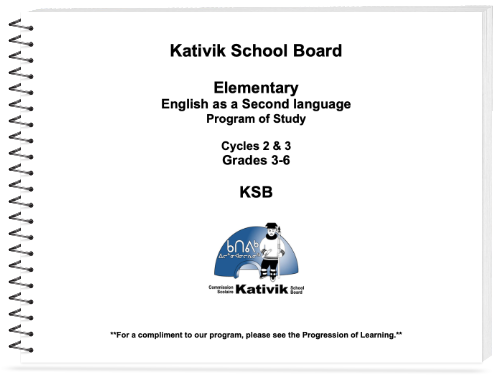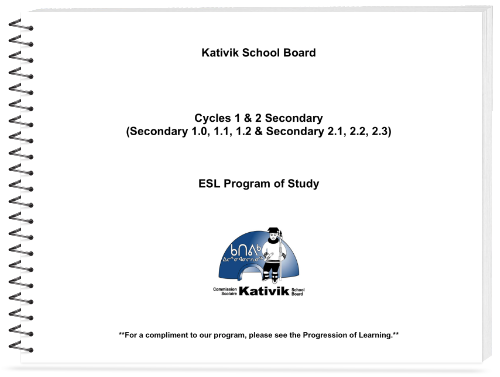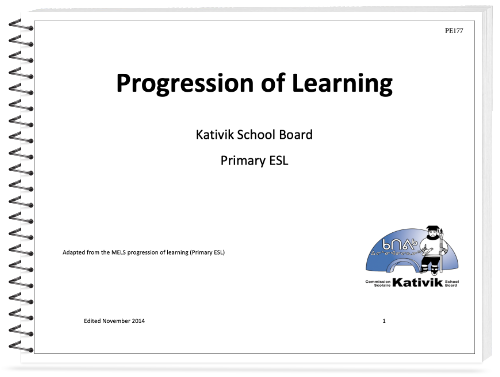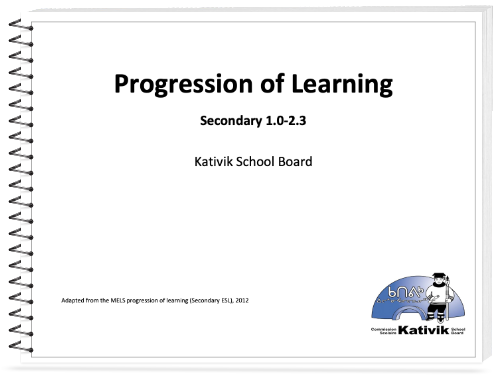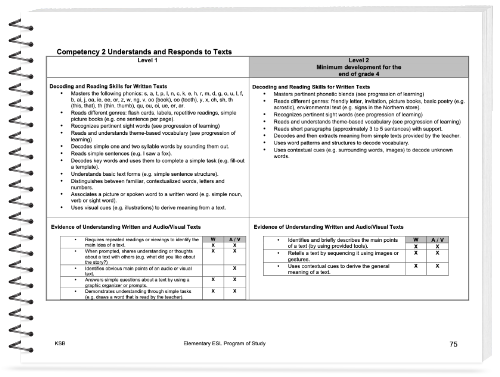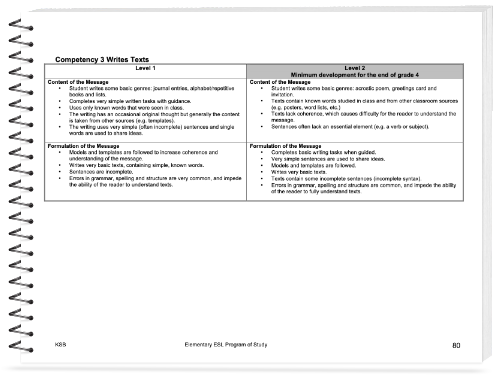Welcome to the English as a Second Language (ESL( curriculum. This information page includes an overview of the curriculum and important information about the program structure, assessment and materials available.
Table of Contents
1. Program Overview
The Kativik school board’s competency-based English Second Language program is taught from grade 3 to secondary 2.3 (often referred to as secondary 5). The program is described and explained in two key documents: the Program of Study and the Progression of Learning.
Inside each document, you will find the scales of learning development that range from level 1 to level 12. To better understand how to teach and evaluate using the scales, Kativik Ilisarniliriniq (KI) offers educators two additional resources: Competency 2 Reading exemplars and Competency 3 Writing exemplars. These two exemplars provide concrete examples of C2 and C3 at each level of the scales of competency.
Educators are encouraged to use all four documents when preparing to teach English as a Second Language and to evaluate students’ language development. KI also recommends that teachers become familiar with the Québec Education Program (QEP) published by MEES, the Ministère de l’Éducation de l’Enseignement supérieur (in English, Ministry of Education and Higher Education).
Program of Study
Although the English as a Second Language (ESL) program differs from the QEP (Quebec Education Plan), it is based on MEES’ requirement. In general, KI’s language programs are competency-based and evaluate students’ ability to use the language in a variety of contexts. The programs observe students’ evolving mastery instead of evaluating how well they perform on a test.
To read complete information about the English as a Second Language curriculum download the Primary / Secondary Program of Study.
Progression of Learning
This document is organized into three sections: 1) progression of learning, 2) essential knowledge, and 3) annex. The first two sections highlight two teaching tools: progression of learning and essential knowledge for English as a second language. These tools reaffirm the crucial role that knowledge plays in the development of the ESL competencies. They outline the knowledge required by students to become competent ESL learners. They assist teachers in their overall planning and also outline when knowledge is to be introduced, practiced and acquired. The tools will help teachers ensure that their students’ learning, in addition to competency development, is consistent with their peer groups across KSB. Overall, when combined, both tools bring consistency to the way English is taught specifically in schools and, more broadly, across Nunavik. In the annex of this document, teachers will find lists of suggested vocabulary and grammar that students require in order to be competent users of English. These lists correspond to items found in the essential knowledge.
2. Assessment
Our language programs are based on competencies and are assessed using the scales of learning development. Here are the three competencies for the English as a Second Language program.
3. Resources
Many resources are available to teach second language in the classroom or online. Our team constantly updates the Nunavik-IcE platform to provide you with Inuit-centered Education resources.
Some of the following resources support reinvestment of knowledge, they are not designed to support the process of constructing knowledge with teacher guidance or the application of knowledge by the end of the school year (for more information, see elements of knowledge in the progression of learning).
Primary Resources
- Nunavik Writes – a collection of texts written by students all over Nunavik
- Eaglecrest Levelled Books
- PM Books
- A-Z Reading Subscription
- LEARN Quebec Subscription
- Inhabit Media educational resources based on some books already available in schools.
Secondary Resources
- Nunavik Writes – a collection of texts written by students all over Nunavik
- Currents4Kids Subscription (contact your educational consultants for more information)
- LEARN Quebec Subscription (contact your educational consultants for more information)
- Inhabit Media educational resources based on some books already available in schools.
4. Communication
Contact your education consultants by email or by phone at 819 964-1136.
- Joanna Rowe – Joanna.Rowe@kativik.qc.ca

